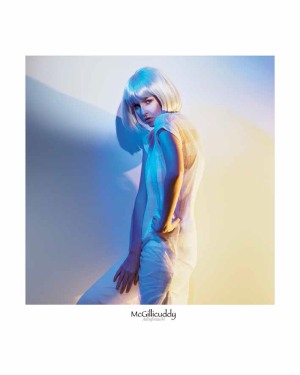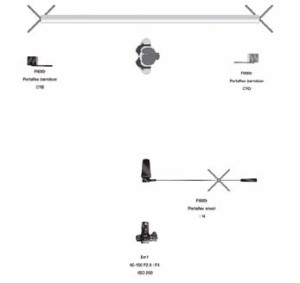articles/Lighting/big-dog-mentor-steroids-page2
Rolling with the Big Dog - Mentor Me on Steroids - part 2 of 1 2 3
by Damian McGillicuddy Published 01/12/2014

This unit again was placed on a stand to camera-right at about waist level to the subject and had the head angled upwards.
Placing the lights like this had the effect of 'sandwiching' the model in two coloured beams of light. Although turned away from the CTO-gelled light because this light had the greater measurable power I guess you could describe it as being the primary accent light. The effect of this is that as the light paths cross the more dominant or powerful light, in thiscase the CTO, it dilutes the strength of the blue light, watering it down in relation to where it might be if only the blue-gelled light is present. That's why the shadows cast by the light to camera-right appear to be the most intense, deeper shades of blue, as no contamination from any other light source is present. It's a very liberating effect because the results are neverquite formulaically assured - the slightest move by the subject can effect the result as the areas struck by either light change.
Knowing that both the strength and the hue of light can have this effect on the image led directly to the placement of my third and final light. Iplaced this FL600r flash on a boomed stand, virtually above my shootingposition, aimed at the model's face. I took another light-manipulating tool from my trusty Portaflex kit and attached it to the unit. My variable snoot allows me to cast a pool of light at the subject; being able to adjust the aperture of the modifier means I can both broaden or narrow the spread of the pool and therefore control just where on the subject I wish to light.

This third 'white light' aimed at the subject's face had the effect of 'washing away' any colour and leaving a more anticipated rendering of colour and tonality. In the samples you can see I start with virtually just the socket of the eye and the cheek lit with this light, before adjusting and opening the aperture of the snoot to cast a bigger pool of light and light more of the subject.
Now I started this article by mentioning technology and it's worth expanding on it here. The reason being that this set of images is slightly unusual for the mega, measuring control freak that I admit to being! This set was shot without ANY use of a light meter, the lights where instead controlled directly off the back of my EM-1 using the RC flash feature. This gives me four groups of flash, three off and one on camera. Hence I can independently control the output of right off the back of the camera should I chose to do so.
Yep sure, because we are using ttl metering, there has to be a little 'organic' growth as to how one arrives at your perfect exposure, it's not a 'measure once' affair as it would be with a meter measuring incident as opposed to reflected light - but blimey it's pretty cool tech once you get to grips with it. The fact that you can see the effects of any adjustment immediately on the back of the camera is a bonus, gone are the days of waiting a minute and thirty for a Polaroid. The main message should be that technology won't just do it for you, its won't negate thinking! All things can become useful tools, all technology used correctly, or even innovatively, can add to the fun and creativity of your shoot but YOU still need to DRIVE it, YOU still need to THINK, YOU still need to be in control - no matter how good the camera is, it can't do it for you without your input. ;0)
Please Note:
There is more than one page for this Article.
You are currently on page 2
- Rolling with the Big Dog - Mentor Me on Steroids page 1
- Rolling with the Big Dog - Mentor Me on Steroids page 2
- Rolling with the Big Dog - Mentor Me on Steroids page 3
1st Published 01/12/2014
last update 09/12/2022 14:51:43
More Lighting Articles
There are 19 days to get ready for The Society of Photographers Convention and Trade Show at The Novotel London West, Hammersmith ...
which starts on Wednesday 14th January 2026





